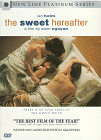| Reviews & Columns |
|
Reviews DVD TV on DVD Blu-ray 4K UHD International DVDs In Theaters Reviews by Studio Video Games Features Collector Series DVDs Easter Egg Database Interviews DVD Talk Radio Feature Articles Columns Anime Talk DVD Savant Horror DVDs The M.O.D. Squad Art House HD Talk Silent DVD
|
DVD Talk Forum |
|
|
| Resources |
|
DVD Price Search Customer Service #'s RCE Info Links |
|
Columns
|
|
|
Sweet Hereafter, The
The story concerns a tragic bus crash in a small town (Banks' home, upstate New York, in the book, Egoyan's native Canada in the film,) that takes the lives of most of the town's children. We meet the townspeople through the character Mitchell Stephens, a lawyer who comes to the town to try to incite the people into various lawsuits. Stephens is portrayed by the great Ian Holm in an extraordinarily complex performance. You can see Stephens switch gears mid-sentence as he tries different tactics to convince the various townspeople to sue. It's incredible that, with over 70 credits to his name at the time of The Sweet Hereafter's release this was Holm's first lead role.
The subtleties and mysteries of the town and its folk should definitely be experienced and I won't go into too much detail. I would, however, like to point out that the film contains beautiful performances from its entire cast, especially Bruce Greenwood and Alberta Watson as grieving parents (of different children), Sarah Polley as the sole child survivor, and Gabrielle Rose as the bus driver, eaten away with guilt and remorse.
I need to briefly discuss the chronology of The Sweet Hereafter. The film jumps back and forth in time and follows an emotional trajectory, not a linear one. While ultimately this makes The Sweet Hereafter a much richer film, allowing it to unfold thematically, some viewers may find themselves momentarily disoriented. Stick it out. It is well worth it. In the era of films like Pulp Fiction and Go audiences are used to tricks involving chronology. The Sweet Hereafter employs this technique to increase the emotional impact of the experiences it portrays.
VIDEO:
Paul Sarossy's gorgeous cinematography is featured here in an incredible transfer that allows you to take in all of the textures of the film. Wood, cloth, flesh, and snow are all used thematically throughout the film and with cinematography this vivid you can almost touch the screen and feel them. The colors are vivid and there is no noticably artifacting. The layer change comes at an intelligent point when the camera is focused on a still object, so you might very well miss it.
AUDIO:
While this is not the kind of film that will give your system a high-octane workout, the audio has been mixed with a careful attention to detail. Subtle shifts in atmosphere and nice use of music bring out the best in a well-balanced system.
EXTRAS:
This New Line release really excels in the extras department. First and foremost is one of the best running commentaries that I have heard to date. Director Atom Egoyan and novelist Russell Banks discuss the film together as it unfolds, illuminating creative decisions, giving thematic insights, and learning new things from each other. Banks seems awed by some of the decisions that Egoyan made that cut right to the heart of his novel, like adding material from the Pied Piper story to parallel what happens to the town. Egoyan is a very intelligent filmmaker and through his commentary he weaves connections between this work and his other films (which, in my opinion, are much more pretentious and much less rewarding than The Sweet Hereafter). Some of these references will be lost on viewers who have not seen such films as Exotica, The Adjuster, and Family Viewing (only the first of these three is available on DVD). Even to the uninitiated he comes across clearly as a director who is working on joining his films with themes like technology's effect on interpersonal relationships. He is not your typical gear-head director (although he does explain how some of the more complex sequences were created) and he doesn't just explain what is happening in the scene you are watching. This commentary is refreshing and enlightening.
Other extras include video of a seminar Egoyan and Banks gave on the film which covers a lot of the same ground as the commentary, but is still interesting, an isolated score track, text and graphics from Robert Browning's beautifully illustrated "The Pied Piper of Hamelin", Charlie Rose's interview with Egoyan, and The Sweet Hereafter's wonderfully edited trailer.
FINAL THOUGHTS:
The Sweet Hereafter may not fulfill the popcorn-entertainment requirements of fans of Bay / Schumacher, but it is in no way a pretentious, divisive art film. The sense of loss and mourning shared by all the characters is something to which we can all relate. The individual ways in which those characters deal with their sadness guarantees that virtually anyone will be moved. A beautiful and complex film, The Sweet Hereafter is a must see for everyone who enjoys challenging films. The wonderful presentation that New Line has given it is just icing on the cake.
Gil Jawetz is a graphic designer, video director, and t-shirt designer. He lives in Brooklyn.
E-mail Gil at [email protected]
|
| Popular Reviews |
| Sponsored Links |
|
|
| Sponsored Links |
|
|
| Release List | Reviews | Shop | Newsletter | Forum | DVD Giveaways | Blu-Ray | Advertise |
|
Copyright 2024 DVDTalk.com All Rights Reserved. Legal Info, Privacy Policy, Terms of Use,
Manage Preferences,
Your Privacy Choices | |||||||












